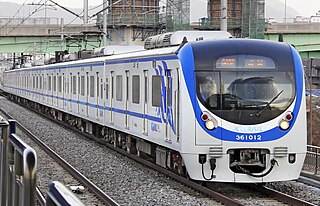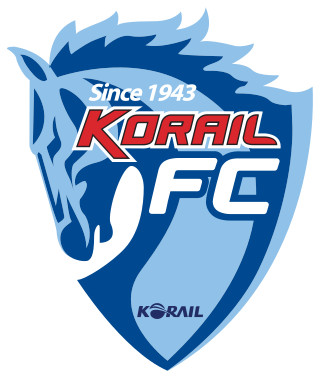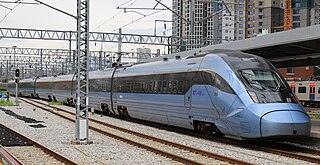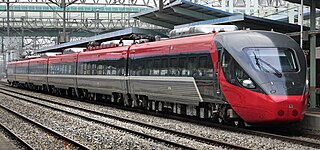| Korail Class 8500 | |||||||||||||||||||||||||||||
|---|---|---|---|---|---|---|---|---|---|---|---|---|---|---|---|---|---|---|---|---|---|---|---|---|---|---|---|---|---|
 Korail Class 8500 in Daejeon Station | |||||||||||||||||||||||||||||
| |||||||||||||||||||||||||||||
| |||||||||||||||||||||||||||||
| |||||||||||||||||||||||||||||
| |||||||||||||||||||||||||||||
The Korail Class 8500 is a South Korean electric locomotive operated by the Korean national railroad operator Korail.
| Korail Class 8500 | |||||||||||||||||||||||||||||
|---|---|---|---|---|---|---|---|---|---|---|---|---|---|---|---|---|---|---|---|---|---|---|---|---|---|---|---|---|---|
 Korail Class 8500 in Daejeon Station | |||||||||||||||||||||||||||||
| |||||||||||||||||||||||||||||
| |||||||||||||||||||||||||||||
| |||||||||||||||||||||||||||||
| |||||||||||||||||||||||||||||
The Korail Class 8500 is a South Korean electric locomotive operated by the Korean national railroad operator Korail.

The Korea Railroad Corporation (Korean: 한국철도공사; Hanja: 韓國鐵道公社, branded as KORAIL, is the national railway operator in South Korea. Currently, KORAIL is a public corporation, managed by Ministry of Land, Infrastructure and Transportation.

The Gyeongchun Line is a regional rail line between Seoul and Chuncheon, South Korea, operated by Korail. Its name is derived from Gyeong and Chuncheon. It was completely reconstructed in the 2000s. Service on it has operated between Sangbong station on the Jungang Line in eastern Seoul and Chuncheon station, as part of the Seoul Metropolitan Subway system, since December 21, 2010. A class of regional rail service named ITX-Cheongchun began operations on February 28, 2012, linking Chuncheon to Cheongnyangni and Yongsan Stations.

Korea Train eXpress (Korean: 한국고속철도), often known as KTX, is South Korea's high-speed rail system, operated by Korail. Construction began on the high-speed line from Seoul to Busan in 1992. KTX services were launched on April 1, 2004.

Hyundai Rotem Co. is a South Korean company that manufactures rolling stock, defense products and plant equipment. It is a part of the Hyundai Motor Group. Its name was changed from Rotem to Hyundai Rotem in December 2007 to reflect the parent company. It is also called Hyundai Railroad Technology Systems.

Seoul Subway Line 4 of the Seoul Metropolitan Subway is a long line crossing from the southwest to the northeast across the Seoul National Capital Area. The central section in Seoul City is operated by Seoul Metro with some trains offering through service to Korail's Ansan and Gwacheon Lines. The southern terminus (Oido) is in Jeongwang 4-dong, Siheung City, and the northern terminus (Jinjeop) is in Jinjeop-eup, Namyangju-si, Gyeonggi-do; the newly built northern section is correspondingly owned by a company owned by Namyangju-si, with operations contracted to Seoul Metro. In 2022, the Seoul Metro operated section had an annual ridership of 219,587,000 or about 601,608 passengers per day.

A hood unit, in North American railroad terminology, is a body style for diesel and electric locomotives where the body is less than full-width for most of its length and walkways are on the outside. In contrast, a cab unit has a full-width carbody for the length of the locomotive and walkways inside. A hood unit has sufficient visibility to be operated in both directions from a single cab. Also, the locomotive frame is the main load-bearing member, allowing the hood to be non-structural and easily opened or even removed for maintenance.

Daejeon Korail FC is a South Korean football club based in Daejeon that competes in the K3 League, the third tier of South Korean football league system. It is owned and operated by Korea Railroad Corporation, South Korea's national railroad operator. Their home venue is Daejeon Hanbat Sports Complex.

Rail transport in South Korea is a part of the transport network in South Korea and an important mode of the conveyance of people and goods, though railways play a secondary role compared to the road network. The network consists of 4,285 km (2,663 mi) of standard-gauge lines connecting all major cities with the exception of Jeju City on Jeju Island, which does not have railways; of the network, 2,790 km (1,730 mi) are double-tracked and 3,187 km (1,980 mi) are electrified. In 2018, rails carried 11.5 percent of all traffic in South Korea – 134.8 million passengers and 30.9 million tonnes of freight – with roads carrying 88.3 percent.

The Korail Class 8200 is a South Korean electric locomotive operated by Korail. This locomotive has head-end power capabilities in place of a dynamo car, which could be used with up to 12 passenger cars.

The Korail Class 8000 locomotive is a series of South Korean electric locomotives operated by Korail. This locomotive was introduced from 1972 to 1990, after electrification of several industrial lines. It was assigned both passenger and freight duty until the introduction of the 8200 series, which restricted the older locomotives to solely freight service. 94 were built, but many have been retired as new replacements enter service.

The Gyeonggang Line (경강선) is a rail line in South Korea, which at present comprises two distinct sections. The first one, which opened on September 24, 2016, is part of the Seoul Metropolitan Subway system in Gyeonggi Province, South Korea, and runs from the city of Seongnam to Yeoju City, partially coinciding with the route of the former narrow-gauge Suryeo Line. The second section, which is located entirely in Gangwon Province, runs between Gangneung and Wonju and opened on December 22, 2017, in anticipation of the 2018 Winter Olympics. This section of the line offers KTX service from Seoul, through the Jungang Line. In the future, the two sections are to be connected, and the Gyeonggang Line will be extended westwards to Siheung.

The KTX-Sancheon is a South Korean high-speed train built by Hyundai Rotem in the second half of the 2000s and operated by Korail since March 2010. With a top speed of 305 km/h (189.5 mph), the KTX-Sancheon is the second commercial high-speed train operated in South Korea and the first domestic high-speed train that is designed and developed in South Korea.

The KTX-I, also known as the TGV-K or Korail Class 100000, is a South Korean high speed train class based on the French TGV Réseau. The 20-car formation of the trainsets without restaurant car is optimized for high capacity. The 46 trainsets were built partly in France and partly in South Korea in the framework of a technology transfer agreement, which was the basis for further domestic high-speed train development in South Korea.
High-speed rail service in South Korea began with the construction of a high-speed line from Seoul to Busan in 1992, and was inspired by Japan's Shinkansen. The first commercial high-speed rail service was launched on 1 April 2004. Currently, South Korea hosts two high-speed rail operators: Korea Train eXpress (KTX) and Super Rapid Train (SRT).

The EMD FT36CW-2, classified as the Class 7000 locomotive under Korail, was a Korean semi-high-speed diesel locomotive. It was built to make the Saemaul Class trains more streamlined before the 1988 Olympics. The locomotives were built between 1986 and 1987 and were all retired between 2011 and 2012 when they reached the end of their 25-year lifespans.

The KTX-Eum or Korail Class 150000 is a South Korean high-speed electric multiple unit train manufactured by Hyundai Rotem and operated by Korail. The word 'eum' in Korean means 'uniting through connection'. This name was selected by members of the public, and expresses the desire to connect regions, people, and happiness through trains.

The KTX-Cheongryong or Korail Class 160000 is an upcoming South Korean high-speed electrical multiple unit train manufactured by Hyundai Rotem and operated by Korail and SR Corporation.

The Korail Class 210000, also known as the EMU-150, is a South Korean higher-speed electrical multiple unit train manufactured by Hyundai Rotem and Woojin Industrial System Company Limited and operated by Korail on ITX-Saemaeul services since 2014.

The Suin–Bundang Line is a commuter rail service of the Seoul Metropolitan Subway system, operating on trackage from the Suin Line and the Bundang Line. Operation began on September 12, 2020.

Intercity Train eXpress-Cheongchun abbreviated as ITX-Cheongchun (Korean: ITX-청춘) is a class of train operated by Korail, the national railroad of South Korea, it was introduced on February 28, 2012. ITX-Cheongchun is the successor of the Gyeongchun Line Mugunghwa-ho which operated until December 2010. It is the only Limited express in Korea, and offers services comparable to those in Japan. In fact, it is known to benchmarking Japan's Limited express. Also, Korea's first double-decker coach was applied. This train connects Seoul, Guri, Namyangju, Gapyeong and Chuncheon. The ITX-Cheongchun trains have a faster average speed of 180 kilometers per hour.